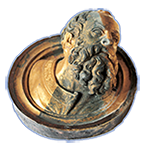Within a research project 1,200 selected ancient Greek bronze coins from the Coin Cabinet, Kunsthistorisches Museum Vienna (KHM), were studied concerning their state of preservation and manufacturing technique. The coins had been minted during the Roman imperial time (50 to 280 AD) using alloys with high lead and/or tin contents. As a result of their burial followed by unfavourable storage...
The Italian Neutron Experimental Station INES, located at the pulsed neutron source ISIS (UK), is a general-purpose powder diffractometer built to focus its use on material science and in particular cultural heritage related studies. Thanks to the high penetration power of thermal neutrons, archaeometric measurements performed through neutron diffraction allow for quantitative determination of...
Together with the microstructure, polycrystalline materials are characterized by their texture. Texture records the thermo-mechanical history of the materials. Quantitative texture analysis of archaeological materials can therefore help to understand technological processes which were applied on the objects in ancient times.
The main advantage of neutron diffraction over X-ray...
The metallurgy of historic weapons such as swords is one of the most interesting topics in archaeometallurgy because these objects were manufactured, over the ages, using the highest quality materials and the most advanced technology. The compositional and microstructural characterization of swords, particularly steel swords, can hence allow us to learn about the technological skills reached...
The metallurgical texture of archaeological metal objects can give clues about the manufacture of the pieces. Texture analysis with neutrons has therefore been used to study objects from the Bronze Age site of Bernstorf in Bavaria, showing that these objects exhibit a very pure cube texture, which is typical for rolled and annealed fcc metals, a method of productuion hardly imaginable for the...
Arms and armour generally supply the most interesting topics for analysis because they employ, for the most pressing reasons, the most advanced technology in any culture at any period. The historical artefacts which display the development of arms and armour over the centuries, are frequently the most fragile. So neutron techniques are vital since they offer completely non-invasive...

